White spiders are often seen on white or colored flowers. These spiders may seem atypical, but their white color acts as camouflage.
White spiders are more difficult for flies to spot whenever they approach flowers for pollen or nectar.
Goldenrod crab spiders are some of the most common white spiders are an example of white spiders that ambush prey, mainly by making the most of their camouflage-white coloring.
Table of Contents
Are White Spiders Venomous?
Most white spiders aren’t poisonous. They rarely bite and they might not be a common sight inside the house.
However, there are a few poisonous white spiders which means you should not handle some of the common white spider species found around parks and gardens.
Non-poisonous
Non-poisonous white spiders can still bite. Some of them are particularly prone to biting at night as they are nocturnal arachnids. These spiders mostly bite campers or those venturing out in nature.
Poisonous
A very small number of white spiders are poisonous. These aren’t deadly to humans, but their mildly-venomous nature inflicts pain and skin necrosis in the area of the bite.
The Northern Yellow Sac spider is one of the mildly-poisonous species known to bite without warning. Its bite is considered painful.
17 Types of White Spiders
The following white spider species are common in North America. Some are native species while others have been accidentally introduced from other continents.
1. Spinybacked Orbweaver
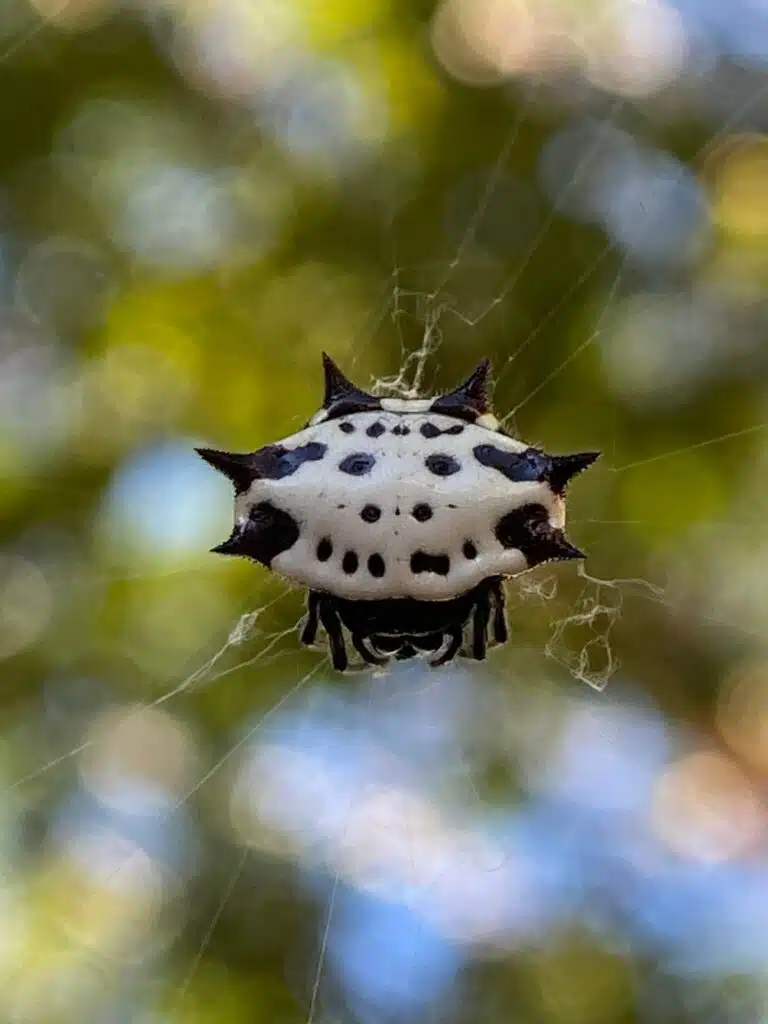
Scientific name: Gasteracantha cancriformis
Common name: Spinybacked Orbweaver
The Spinybacked Orbweaver is native to North America and parts of Central America. It’s one of the most common white spiders around homes.
Spiders of the genus are very common in gardens and around woodlands where they can be picked by hand.
The species isn’t venomous and it’s often found in shrubs or trees around homes, particularly next to citruses.
Spiders of this genus get their name from the 6 spines on their back. They improve the defensive techniques of the species.
Mostly white, this spider is known for its white dorsal with black spots.
Females are easier to spot since they measure up to 9mm, with the average female measuring around 7mm.
Male Spinybacked Orbweaver spiders are considerably smaller with an average size of 2mm.
Females spin orb-shaped spider webs where they catch all types of bugs and insects.
These spiders are generally seen as beneficial around homes as they routinely catch and eat mosquitoes, moths, and even beetles.
Female Spinybacked Orbweaver spiders can also eat larger flies. Females trap these large flies on the center spot of the weave, believed to be more robust when it comes to larger flies.
2. Goldenrod Crab Spider
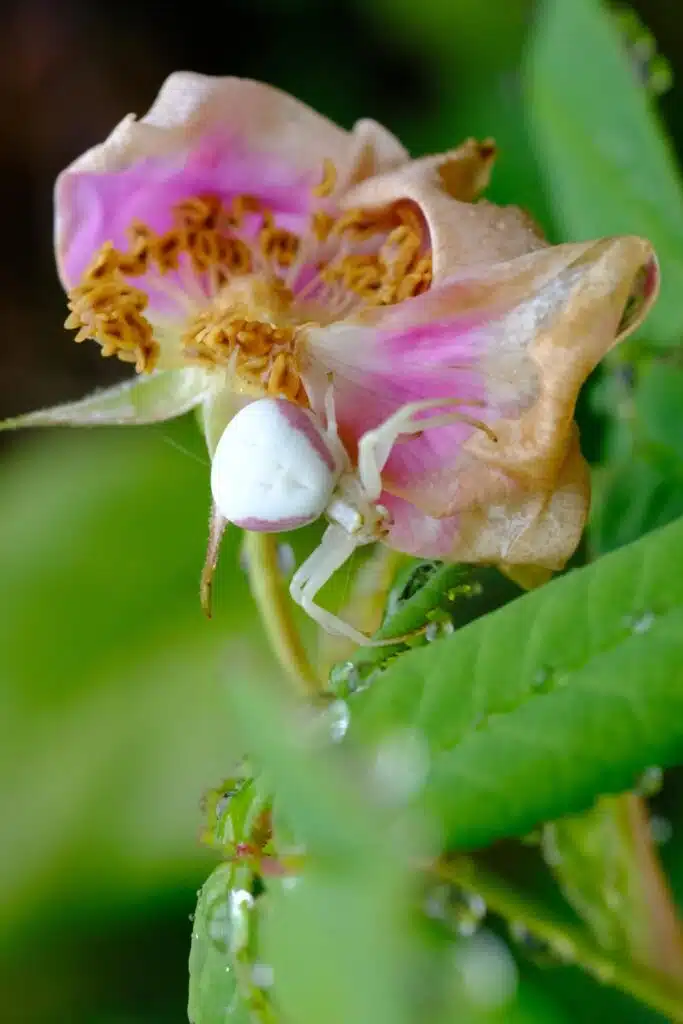
Scientific name: Misumena vatia
Common name: Goldenrod Crab Spider, flower (crab) spider
Goldenrod Crab Spiders get their name from the sideways positioning of their legs which resemble the legs of crabs.
Spiders of this genus come in multiple colors but the pale yellow and white versions of the species are more common.
Makes tend to be seen in white coloring with pink lines more than females which are also white but which can also be pale yellow at times.
Both males and females have either red or pink lines along the sides of the body.
Spiders of this genus are known for their rather camouflage-like color as they sit on white or yellow flowers.
Unlike web-weaving spiders, Goldenrod Crab spiders don’t spin webs.
These spiders are predatory.
Goldenrod Crab spiders eat pollinator insects such as bees and wasps. They ambush them as they approach flowers for feeding.
One of the distinct traits of this species is the ability to alter its color.
Spiders of this genus can slightly change their color to appear white or golden depending on the flower they sit on.
This is their ultimate method of adapting camouflage to catch more pollinating insects.
3. Spined Micrathena
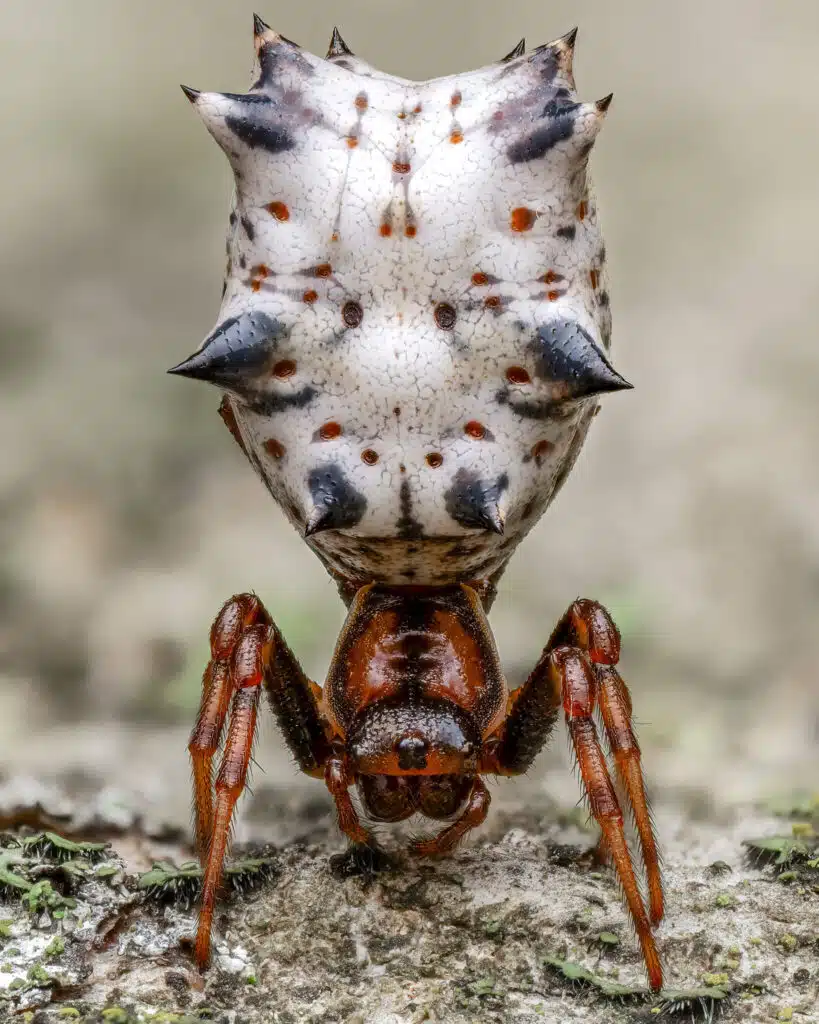
Scientific name: Micrathena gracilis
Common name: Spined Micrathena, castleback orbweaver
The Spined Micrathena spider species gets its name from its reduced body size. Often overlooked, this small spider can sometimes be white.
Females and males of the species have a black and white body with black spines seen on the sides of their abdomen.
Female spiders are larger than males, growing to a maximum size between 7 and 10mm.
Male Spined Mucrathena spiders grow to a size between 4.5 and 5mm.
While small, the SPined Micrathena spider can still catch insects larger than its body size.
For this reason, it spins wheel-shaped spider weaves which are seen in dense shrubs or around trees to catch various insects.
This spider web is typically positioned vertically, as with all orbweaver species.
Spined Micrathena spiders can be seen around this spider web all day.
Spiders of this genus are active from spring to late October.
They overwinter as eggs and emerge late in the season, just as summer begins.
4. Northern Yellow Sac Spider – Poisonous White Spider in House
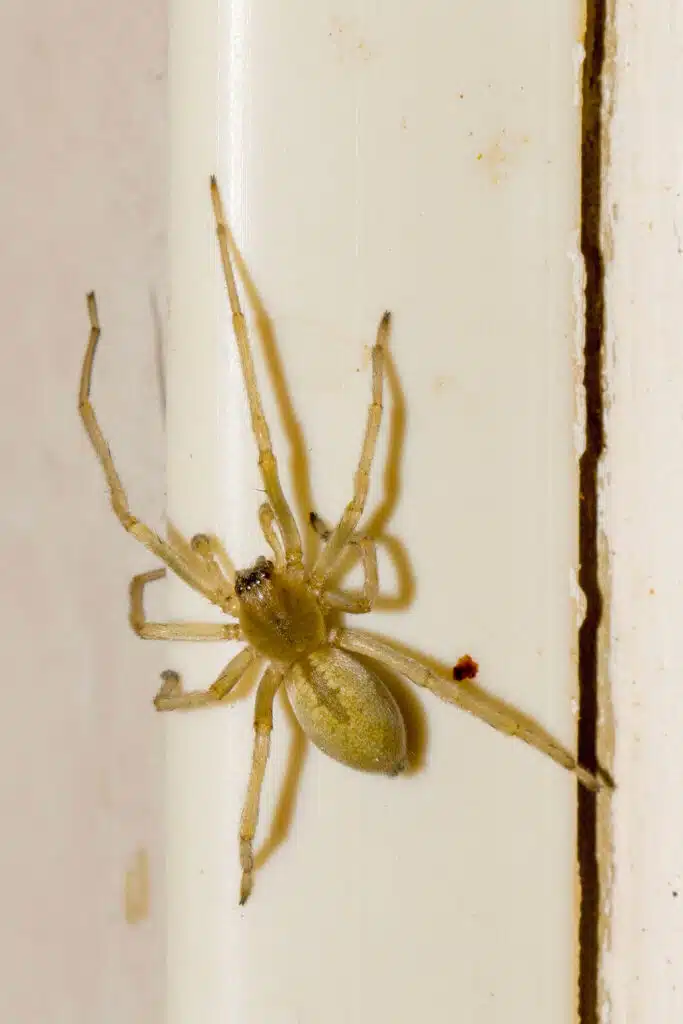
Scientific name: Cheiracanthium mildei
Common name: Northern Yellow Sac Spider
The Northern Yellow Sac spider is the name of multiple similar spider species living in Africa, Asia, and North America.
Northern Yellow Sac spiders have been introduced to North America where they are now known as some of the most aggressive spider species to be found in gardens.
These spiders bite without provocation. This bite is very painful and it might lead to skin necrosis.
Northern Yellow Sac spiders are small and tan, almost white in their coloring.
As their name implies, they weave small sacs where they spend the day. These sacs are the shelter they live during the night to go out and hunt.
The species is predatory and nocturnal.
This venomous spider species is a common occurrence in camp sites and other locations where people hike or go outdoors as they’re attracted to light at night.
5. American Green Crab Spider
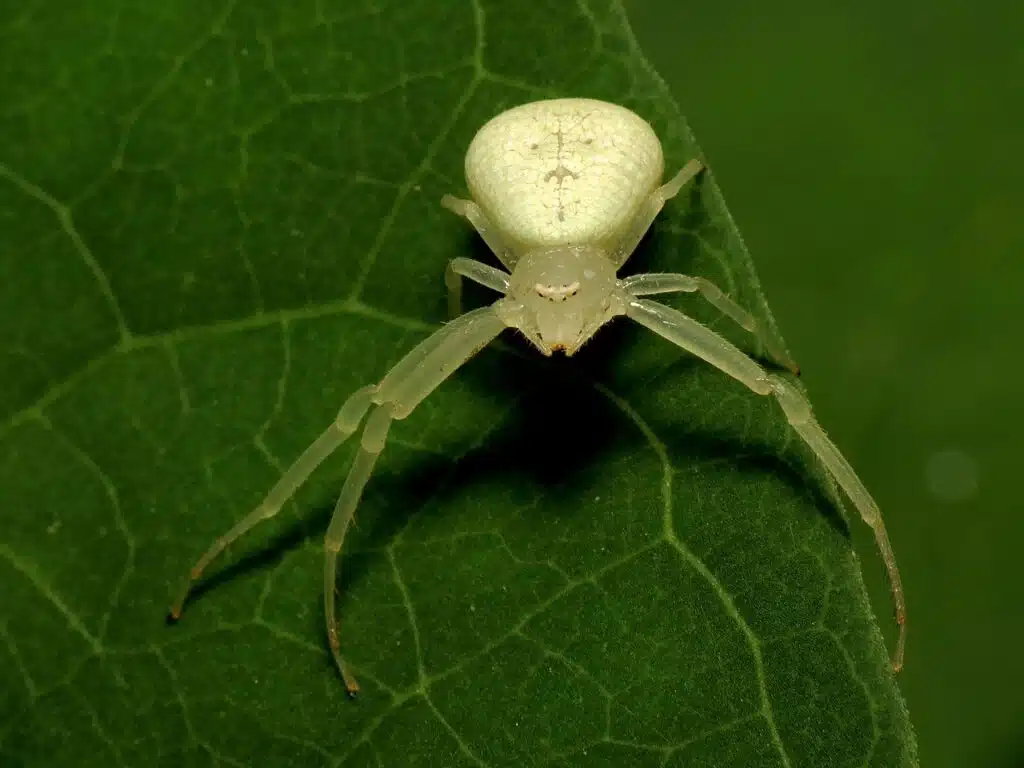
Scientific name: Misumessus oblongus
Common name: American Green Crab Spider
The American Green Crab Spider grows to a size between 3 and 7mm. Females are twice the size of males.
Spiders of this species are known to be pale green with the capacity to adapt to an almost all-white color.
Their camouflage coloring is used when sitting on flowers and looking for insects to prey on.
American Green Crab spiders eat bees and beetles. They are also seen eating larger prey such as butterflies.
Mating is a complex process for the species.
Females lay eggs in a sack and they remain close to it for a while before dying.
Spiderlings hatch a few days later as miniature adults.
As their name implies, the species has legs that resemble the legs of crabs.
This allows them to move sideways easier.
The forelegs of the species are long and they resemble crab legs the most.
6. White-banded Crab Spider
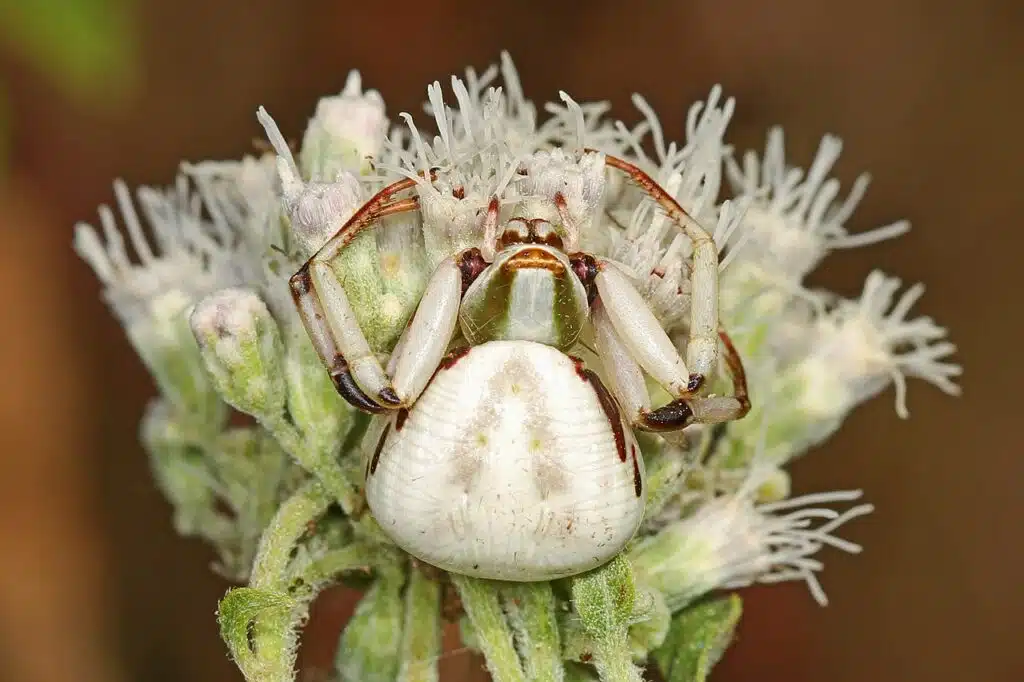
Scientific name: Misumenoides formosipes
Common name: White-banded Crab Spider
The White-banded Crab spider is a species that’s either white or yellow. These spiders can change their color to match the color of the flowers they live on.
Spiders of the genus are predatory. They sit on flowers waiting for the perfect chance to ambush insects and even other crab spiders.
These spiders resemble crabs in their leg movements.
The front legs of the White-banded Crab spider are longer. These pairs of legs are used to pin down prey.
White-banded Crab spiders don’t spin spider webs.
Mating competition between male White-banded Crab spiders is high.
This is one of the few spider species where an adult male guards a female until sexual maturity is reached so they can mate.
Both males and females can be seen on white or yellow flowers.
It can take a few days for this spider to change its color from white to yellow or from yellow to white.
This is achieved by their monochrome pigments.
7. Gray Wall Jumping Spider
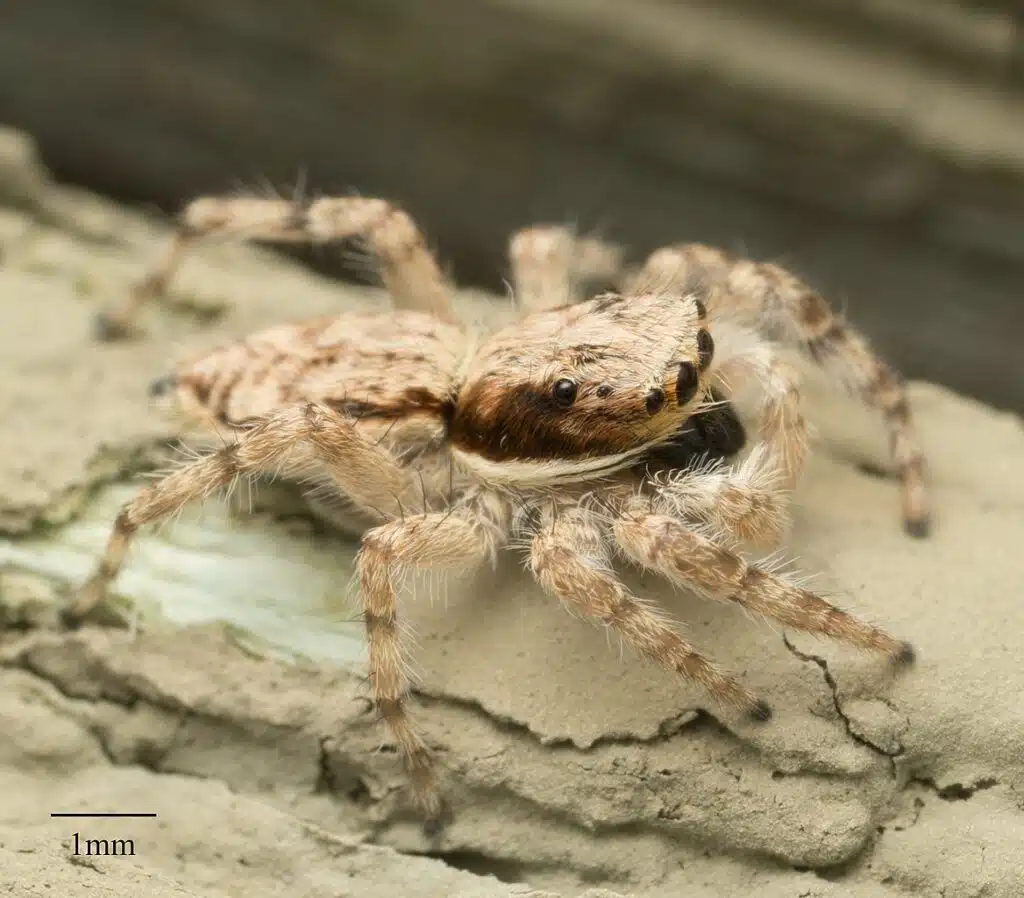
Scientific name: Menemerus bivittatus
Common name: Gray Wall Jumping Spider
The Gray Wall Jumping Spider is a common species in the Southern US. This spider is known for its capacity to jump.
As a jumping spider, the Gray Wall Jumping spider is mostly seen around homes.
This black and white species has distinct V-shaped marks on its dorsal as a unique characteristic.
Spiders of this genus jump long distances and pounce on prey based on very good vision.
Gray Wall Jumping spiders are active all year since they mostly live indoors.
The mating season is also specific to indoor species s it starts in the fall and lasts until spring.
Female Gray Wall Jumping spiders lay up to 60 eggs at a time.
You can see these nocturnal species on exterior home and garage walls at night.
This is where insects are attracted to outdoor lights and where these spiders have the best chances of catching them.
8. White-jawed Jumping Spider – Tiny White Spider
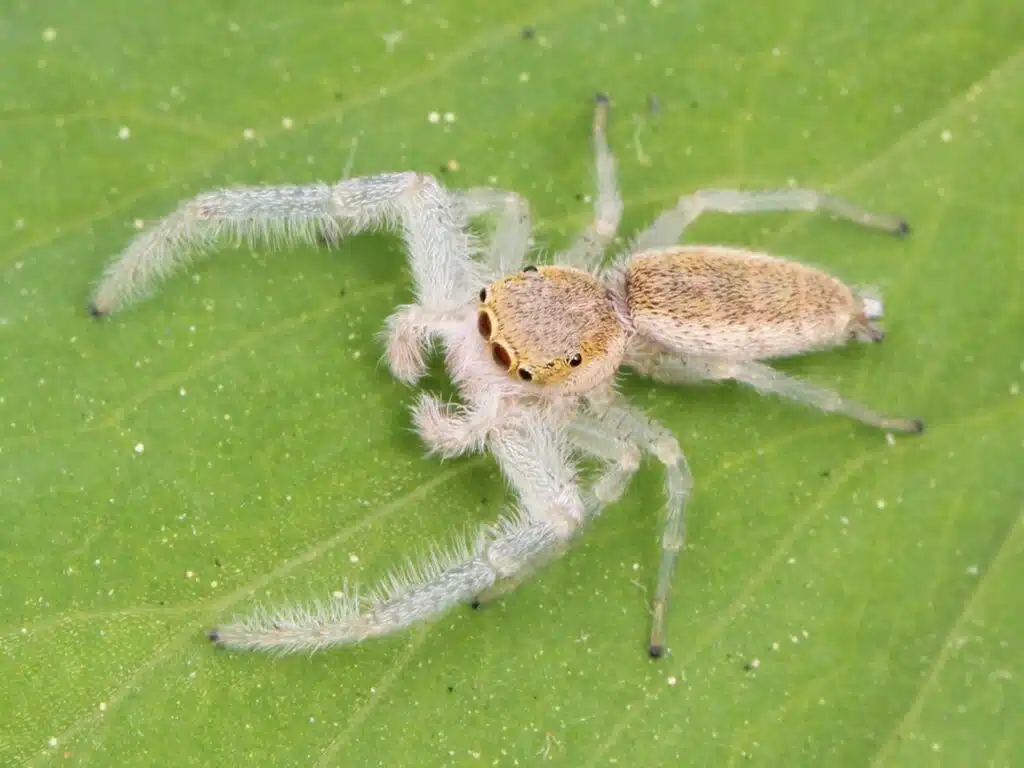
Scientific name: Hentzia mitrata
Common name: White-jawed Jumping Spider
White-jawed Jumping spiders are part of the Salticidae family. These spiders are known for their elongated body and hairy legs.
Most body parts of this spider are white. The short hairs on its legs are also white.
Golden coloring is specific to the dorsal of the species.
White-jawed Jumping spiders catch insects and small bugs by actively hunting for them as they don’t spin webs.
The diurnal and nocturnal species are known for having very good vision.
White-jawed Jumping spiders have 4 eyes distributed on a single row. The pair of central eyes are larger while the outer pair of eyes are smaller.
Spiders of the genus are found in the US and can be seen around homes where they hunt for insects attracted to artificial light.
9. Striped Lynx Spider
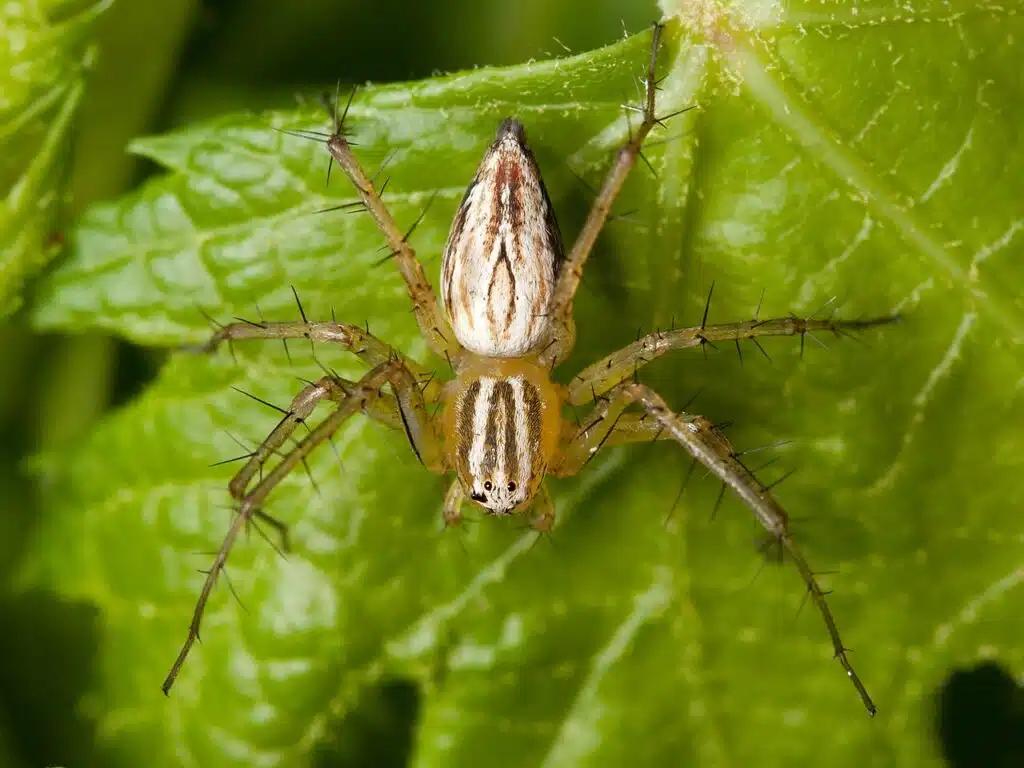
Scientific name: Oxyopes salticus
Common name: Striped Lynx Spider
The Striped Lynxh Spider is identified by its tan-brown body with thick white lines. It also has distinct black long hairs on its legs.
These spiders are seen as beneficial in agriculture. They eat detrimental flies to the point of extinction from crops.
Striped Lynx spiders are part of a complex species that use the odors of certain flies to move towards or away from an area.
Research shows these spiders can learn certain types of fly odors as spiderlings.
This is a period where Striped Lynx spiders aren’t known for eating flies as their spiderlings only eat nectar and honeydew.
Many Striped Lynx spiders can be found in crops where farmers use them to control pests such as bollworms and tobacco budworms.
This species is also common on soybean crops.
You can identify these spiders among other white species by their small size in the case of males.
Growing up to 4mm male spiders are considerably smaller than the 16mm females of the species.
Spiders of this species mate multiple times per year in the case of males and once per year in the case of females.
The female Striped Lynx Spider lays an egg sack on the underside of leaves of various crops to protect the eggs from predators.
10. Garden Ghost Spider
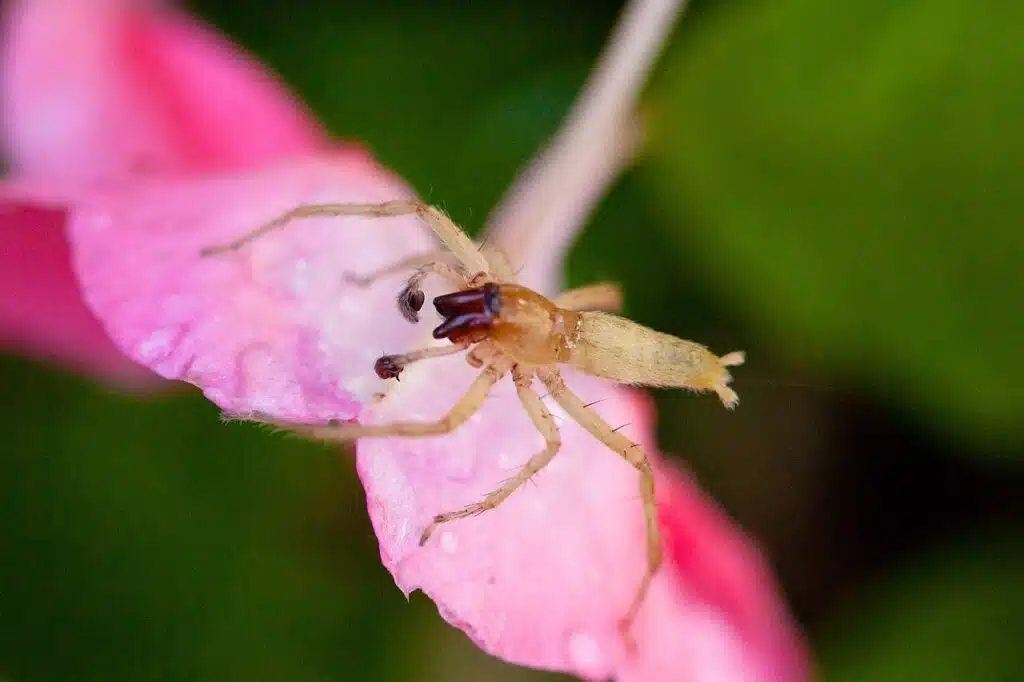
Scientific name: Hibana gracilis
Common name: Garden Ghost Spider
The Garden Ghost Spider is a species seen in multiple colors, including in an off-white version around gardens and man-made structures.
These spiders grow to about 0.5 inches at most and they can be identified by their long legs and by the black marks on their heads.
Most of the day is spent in a small cocoon-like web these spiders spin for themselves.
They are seen in tall grass, under leaves, or under piles of wood around the yard where they hide until the night when they become active hunters.
Garden Ghost spiders are active all year in warm climates such as Florida habitats.
They enter a state similar to hibernation in the winter when found in colder states where they can overwinter as spiderlings.
It’s best to avoid handling these species as it’s known for their painful bite.
11. White Micrathena
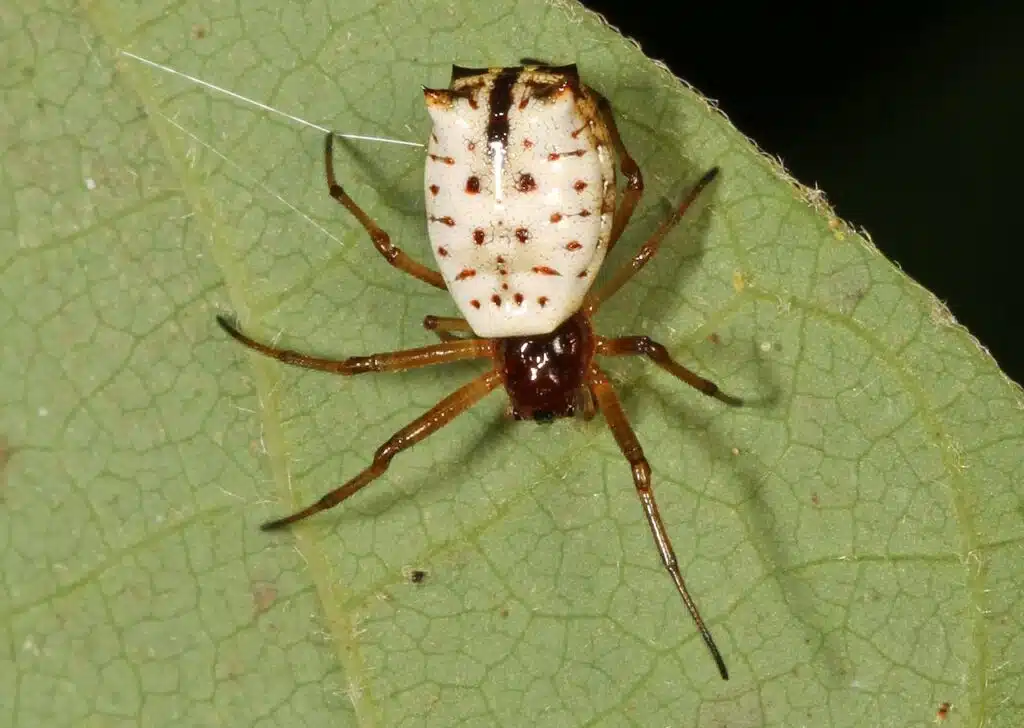
Scientific name: Micrathena mitrata
Common name: White Micrathena
White Micrathena spiders are identified by their mostly white body. They have a white color with small black marks and dark color legs.
Spiders of the genus are very common in gardens. While small, they can easily be spotted due to their white color.
These spiders build spider webs against a range of insects such as mosquitoes.
Many see them as beneficial spiders as a result.
These spiders are small, but they can catch larger insects as well.
Males reach a size of up to 3mm while female spiders grow to 6mm.
One of the largest concerns with the species is the number of webs they build around the garden as both males and females can build webs.
These spider webs are beneficial to homeowners as they trap mosquitoes and other invasive flies and various gnats.
12. Humpbacked Orbweaver
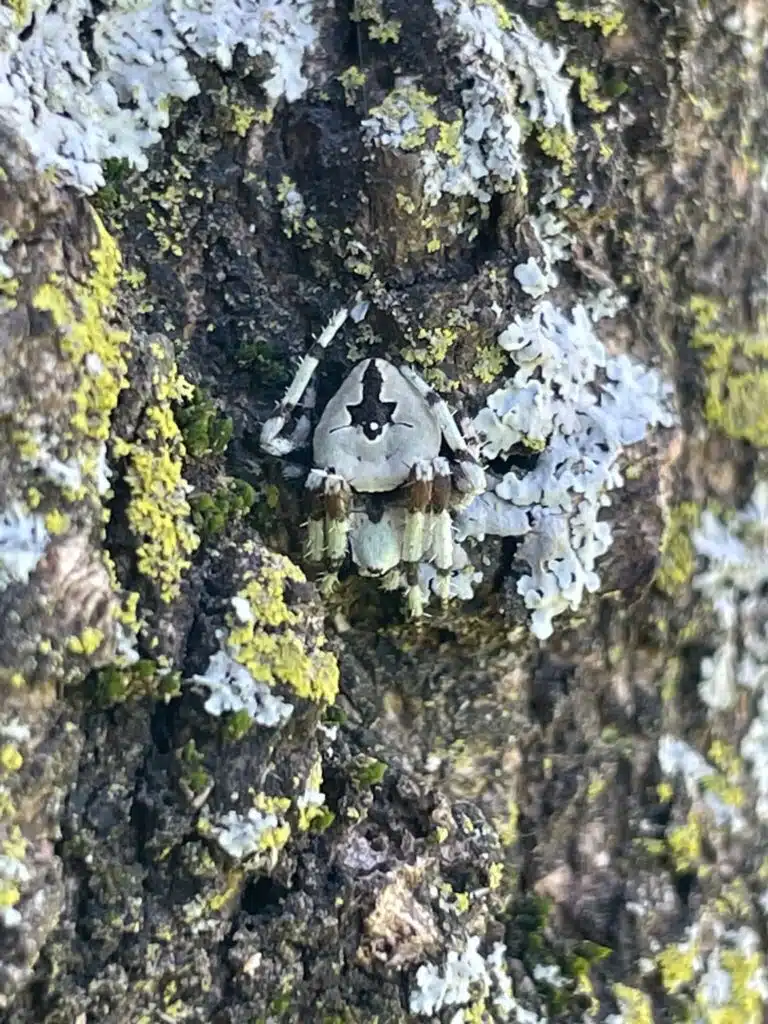
Scientific name: Eustala anastera
Common name: Humpbacked Orbweaver
The Humpbacked Orbweaver is a spider species seen in multiple colors, mostly in a brown and tan color.
However, the species is also seen in white color with small black marks on the dorsal and on the legs.
As an orbweaver, the spider is known for building silk webs.
However, the species appears similar to jumping spiders, particularly due to its robust legs.
April is the best time for seeing this species as it emerges in North and Central America.
13. Common Candy-striped Spider
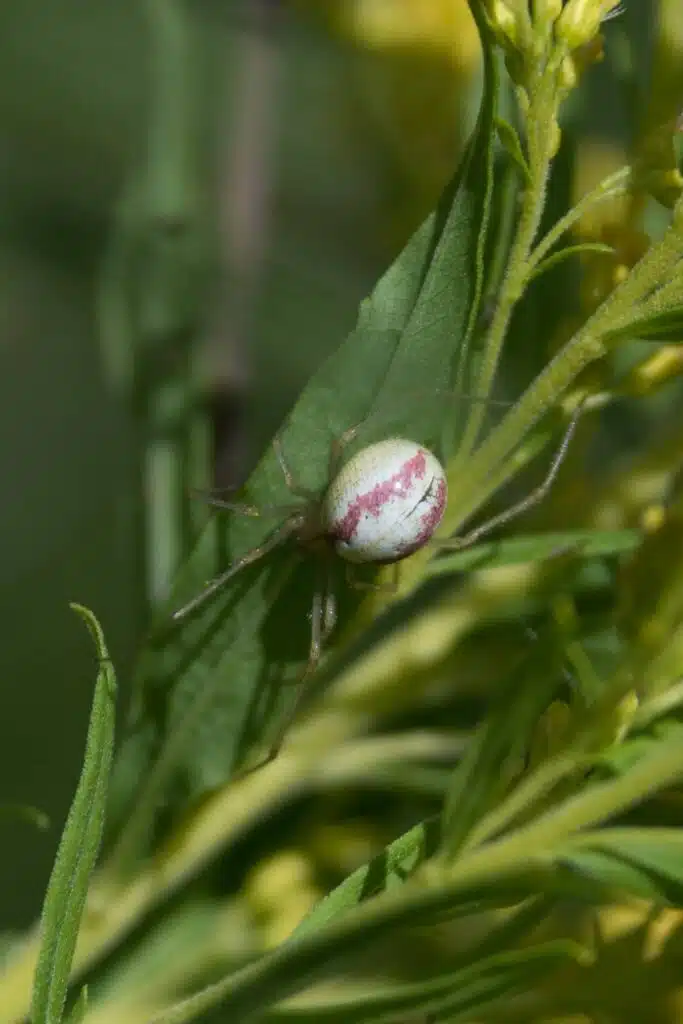
Scientific name: Enoplognatha ovata
Common name: Common Candy-striped Spider
The Common Candy-striped spider was introduced to the United States from Europe.
It comes in multiple colors and it’s identified by its bulbous abdomen. These spiders often come in white color with dark green stripes.
It has translucent legs which often feature a hint of green coloring.
Spiders of the genus can partially alter their color depending on their habitat.
It can take up to 3 days for their color to alter from white to pale green or to pale yellow.
Common from late spring to late fall, the spider is considered both beneficial and harmful.
It eats common predatory wasps but it also eats bees and other flies.
Females of the genus are known to guide deposited eggs. The female spider lays egg sacks and it then guards them against potential predators.
14. Oblong Running Spider
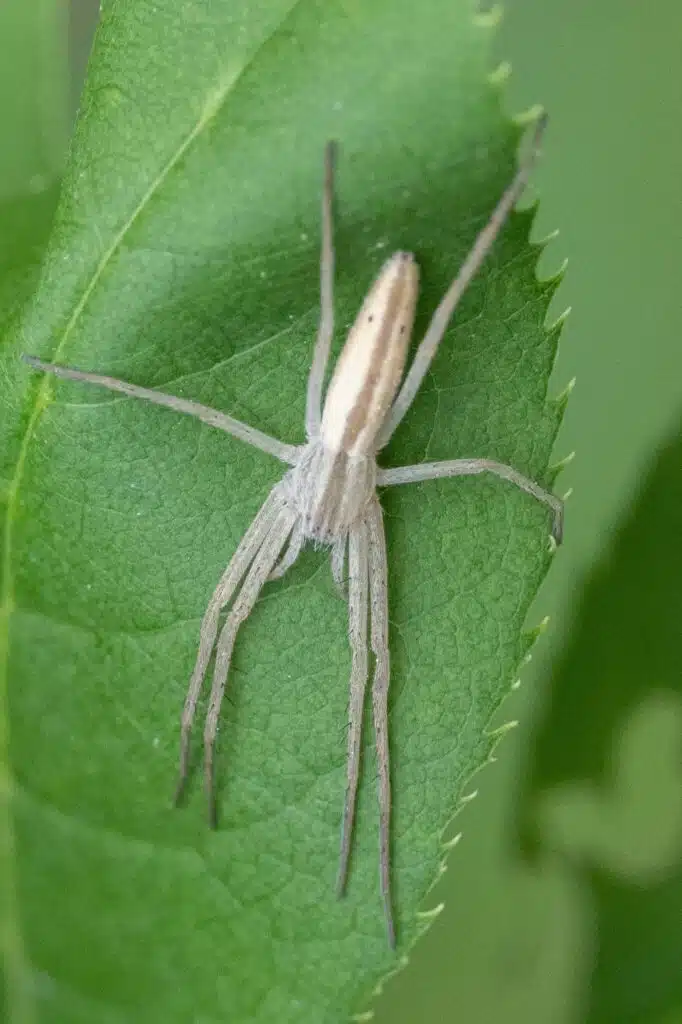
Scientific name: Tibellus oblongus
Common name: Oblong Running Spider
Found in dryland and grassland, the Oblong Running Spider is seen in different colors from green to white. This species is identified by its dark lines that run across the middle of the abdomen.
Its way range of habitats makes this spider a common sight in North America.
The spider is active from May to September where it can be seen in orchards, parks, grassland, and woodlands.
Known as a medium to large species, the Oblong Running spider grows up to 10mm.
Females are larger than males but they can’t be separated without microscopic analysis of their genitalia.
15. Green-legged Orbweaver
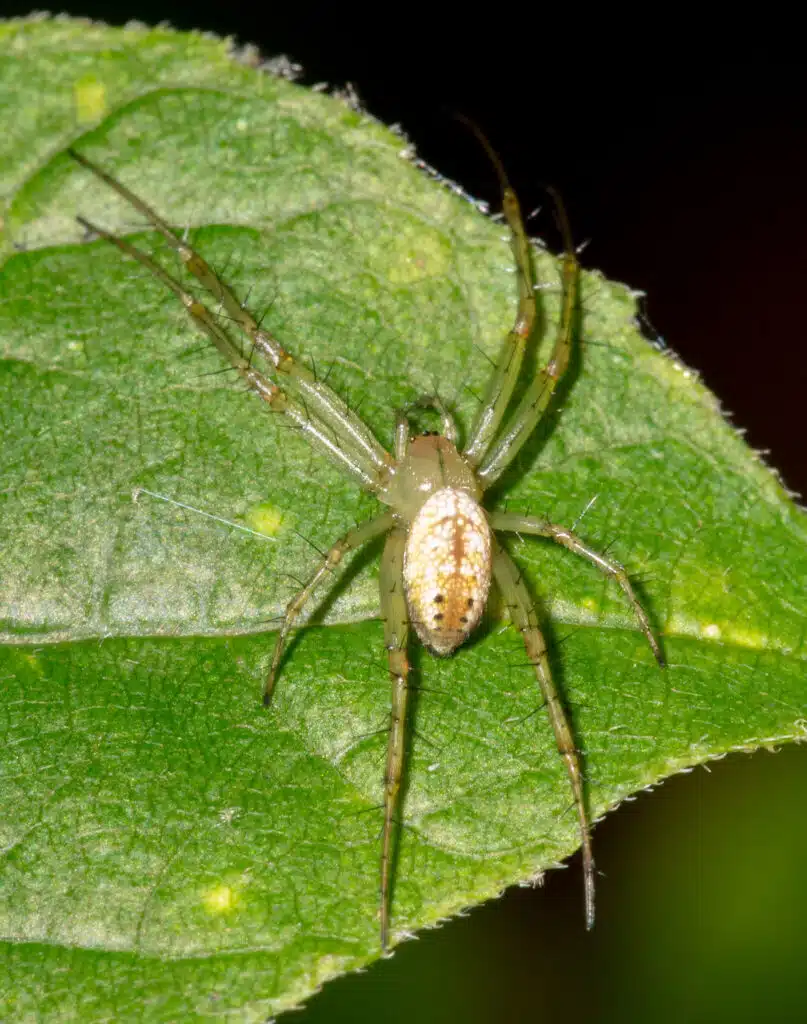
Scientific name: Mangora maculata
Common name: Green-legged Orbweaver
The Green-legged Orbweaver gets its name from the green colors of its legs. It has dark green legs and a white dorsal.
The white dorsal of the spider is known for also having green spots making this species similar to the Marbled orbweaver in coloring patterns.
The Green-legged Orbweaver is a species where females are larger than males. Both can build spider webs but females build larger webs.
Mating typically occurs on the spider web for this species. Male spiders approach the web and make their way to the center point where the female is.
The male tries to move without causing too many spider web vibrations as it may end up being eaten by the female.
Other males prefer female luring tactics for mating. The male builds a smaller spider web next to the web of the female.
Males then connect a silk line between the spider webs and start to vibrate their small webs to attract the female for mating.
Both the male’s and the female’s spider webs are barely visible or not visible to insects that get caught up in them as prey.
16. Kidney Garden Spider
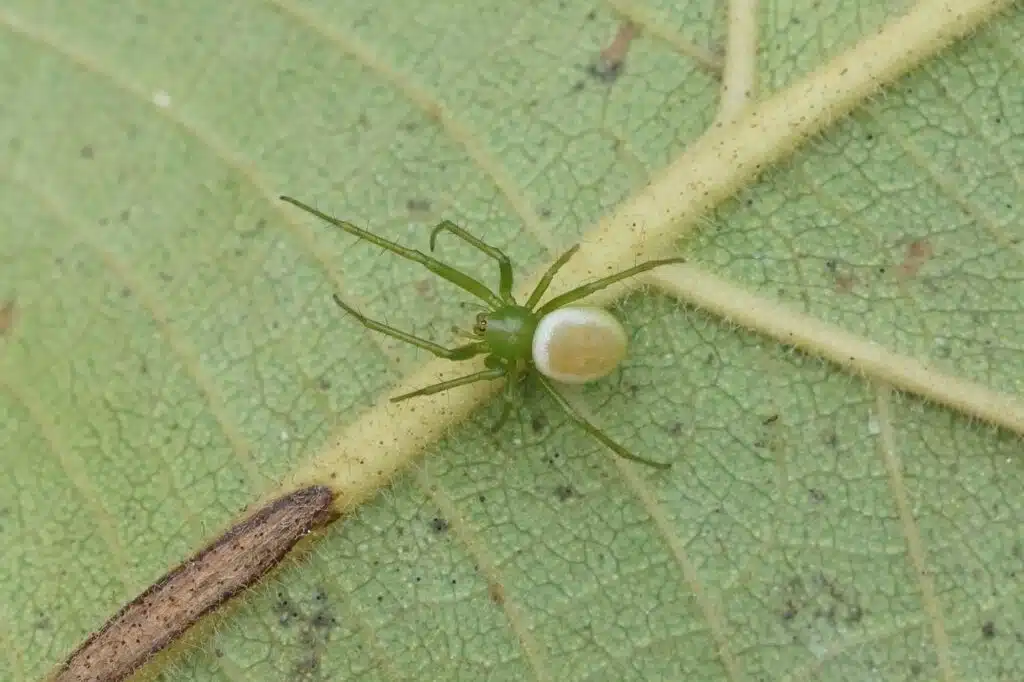
Scientific name: Bijoaraneus mitificus
Common name: Kidney Garden Spider
The Kidney Garden spider is mostly white. It’s an orbweaver which means it spins an orb-shaped web.
This species is characterized by its white and green coloring. Its abdomen is white while its head and legs are green.
Females are larger than males.
Female Kidney Garden spiders grow up to 9mm while males grow up to 5mm.
Known for their bulbous abdomens, these are spiders known for building complex webs.
Spiders don’t sit in the center of the web as they prefer to build a smaller cocoon-like web nearby.
Female spiders build the largest webs.
Males also build webs. However, the webs of males are smaller and typically found next to larger female webs.
These webs are very common in gardens. You can find them in shrubs, among flowers, or in dense plants such as lemongrass.
These spiders are known for always sitting next to their spider webs, just in case, any insect gets trapped in them.
They are tied to the web with a thin silk line. Spiders can’t be seen as they either hide in a smaller web or a curled leaf.
Spiders always come out whenever their webs vibrate. This is the signal an insect has been trapped in the web.
All webs are restored at night if damaged during the day.
17. Australian Golden Orbweaver – White Spider With Red Legs
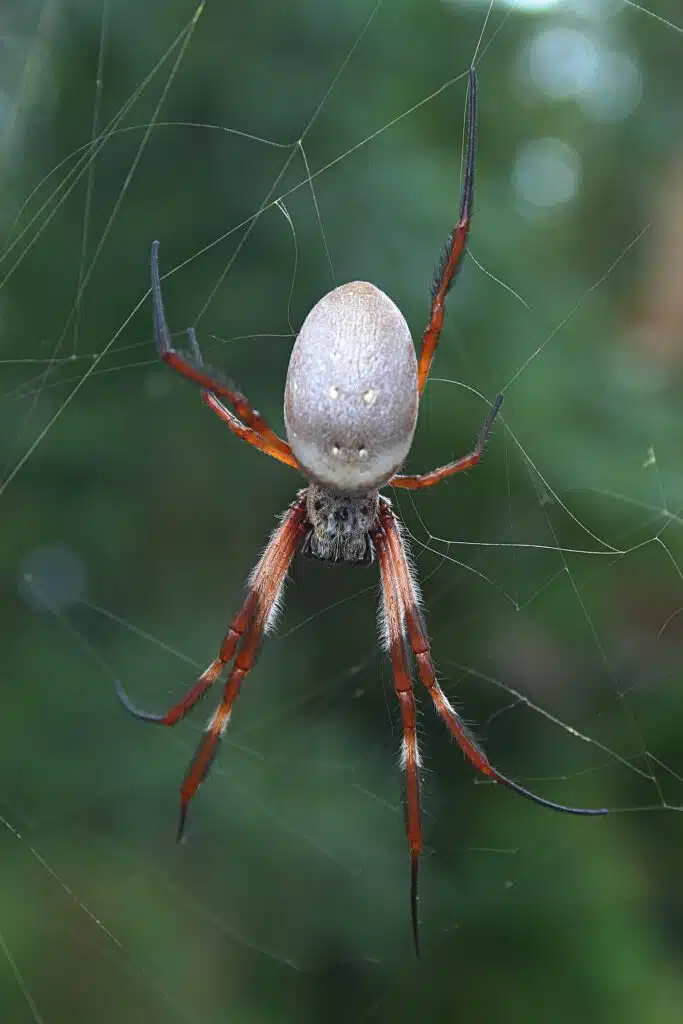
Scientific name: Trichonephila edulis
Common name: Australian Golden Orbweave
This species is one of the largest white spiders in the world. Australian Golden Orbweavers are very common in Indonesia, Australia, and New Guinea.
This species is characterized by a mostly white body and dark brown legs.
It weaves one of the strongest orbweavers weaves which catches all types of large and small prey.
The spider web of the Australia Golden Orbweaver is so strong that even small birds can get caught up in it.
Females are known for building these strong webs and they eat all types of insects, bugs, and small birds.
The females of the species are very large, growing to 40mm.
Males are considerably smaller, rarely growing to a size of 10mm.
The webs of the Australian Golden Orbweaver are made by the female but they also host male spiders.
Some females prefer to host multiple male spiders on their webs. This is believed to be a matter of preference.
Females rarely live on the web. Even in the face of danger, they prefer to escape to the upper side of the web, but they only drop to the ground when in true danger.
The Australian Golden Orbweaver is known to produce almost 400 eggs per season as a prolific breeder.
This species is also seen as food in some parts of the world.
Australian Golden Orbweavers are roasted and eaten in Papua New Guinea where this large orbweaver is seen as a delicacy.
Further Reading: